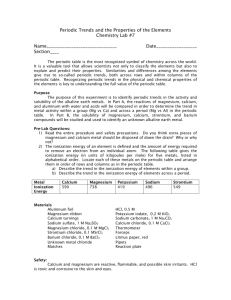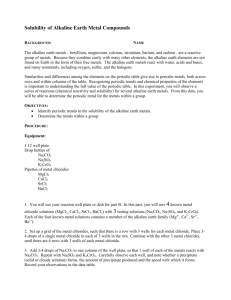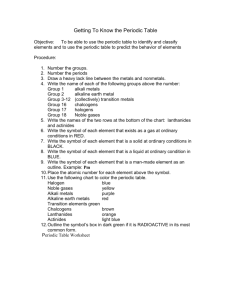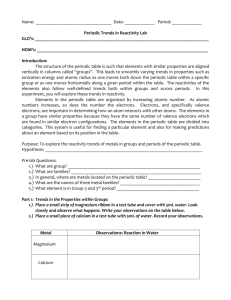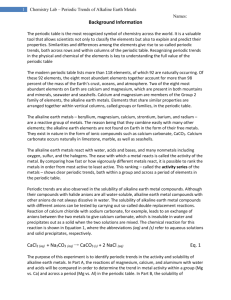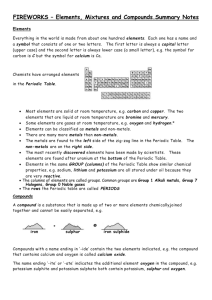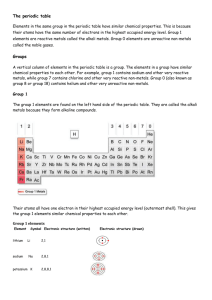Periodic Trends and the Properties of Elements
advertisement
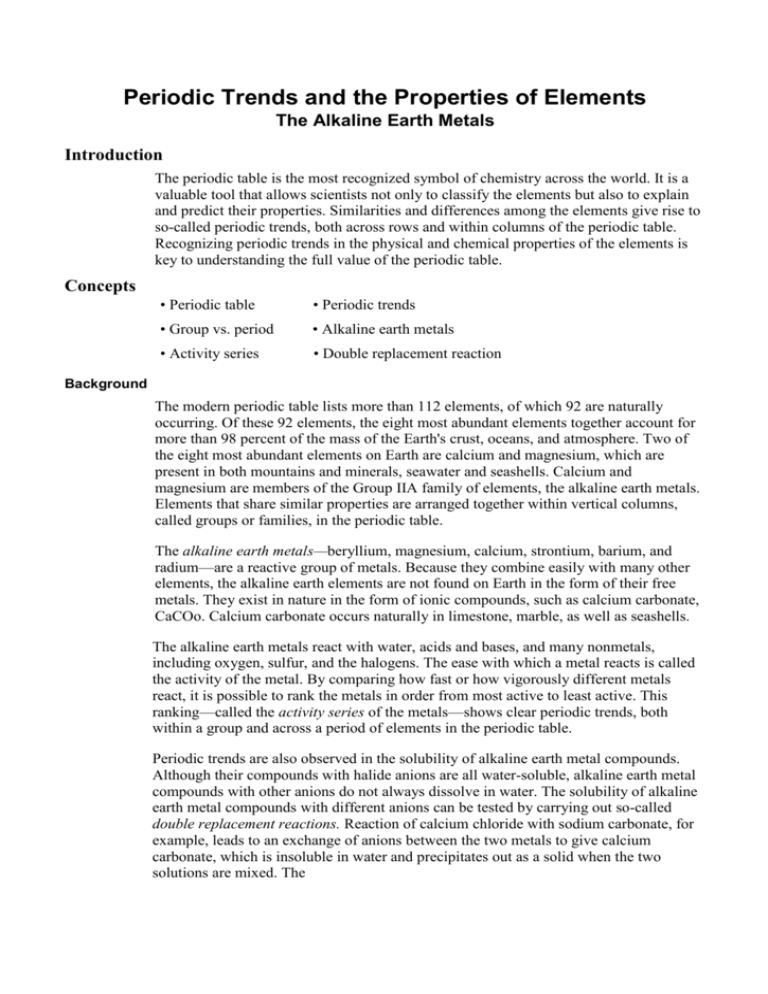
Periodic Trends and the Properties of Elements The Alkaline Earth Metals Introduction The periodic table is the most recognized symbol of chemistry across the world. It is a valuable tool that allows scientists not only to classify the elements but also to explain and predict their properties. Similarities and differences among the elements give rise to so-called periodic trends, both across rows and within columns of the periodic table. Recognizing periodic trends in the physical and chemical properties of the elements is key to understanding the full value of the periodic table. Concepts • Periodic table • Periodic trends • Group vs. period • Alkaline earth metals • Activity series • Double replacement reaction Background The modern periodic table lists more than 112 elements, of which 92 are naturally occurring. Of these 92 elements, the eight most abundant elements together account for more than 98 percent of the mass of the Earth's crust, oceans, and atmosphere. Two of the eight most abundant elements on Earth are calcium and magnesium, which are present in both mountains and minerals, seawater and seashells. Calcium and magnesium are members of the Group IIA family of elements, the alkaline earth metals. Elements that share similar properties are arranged together within vertical columns, called groups or families, in the periodic table. The alkaline earth metals—beryllium, magnesium, calcium, strontium, barium, and radium—are a reactive group of metals. Because they combine easily with many other elements, the alkaline earth elements are not found on Earth in the form of their free metals. They exist in nature in the form of ionic compounds, such as calcium carbonate, CaCOo. Calcium carbonate occurs naturally in limestone, marble, as well as seashells. The alkaline earth metals react with water, acids and bases, and many nonmetals, including oxygen, sulfur, and the halogens. The ease with which a metal reacts is called the activity of the metal. By comparing how fast or how vigorously different metals react, it is possible to rank the metals in order from most active to least active. This ranking—called the activity series of the metals—shows clear periodic trends, both within a group and across a period of elements in the periodic table. Periodic trends are also observed in the solubility of alkaline earth metal compounds. Although their compounds with halide anions are all water-soluble, alkaline earth metal compounds with other anions do not always dissolve in water. The solubility of alkaline earth metal compounds with different anions can be tested by carrying out so-called double replacement reactions. Reaction of calcium chloride with sodium carbonate, for example, leads to an exchange of anions between the two metals to give calcium carbonate, which is insoluble in water and precipitates out as a solid when the two solutions are mixed. The chemical equation for this reaction is shown in Equation 1, where the abbreviations (aq) and (s) refer to aqueous solutions and solid precipitates, respectively. CaCl2(aq) + Na2CO3(aq) → CaCO3(s) + 2NaCl(aq) Equation 1 calcium chloride sodium carbonate calcium carbonate sodium chloride Experiment Overview The purpose of this experiment is to identify periodic trends in the activity and solubility of the alkaline earth metals. In Part A, the reactions of magnesium, calcium, and aluminum with water and acids will be compared in order to determine the trend in metal activity within a group (Mg vs. Ca) and across a period (Mg vs. Al) in the periodic table. In Part B, the solubility of magnesium, calcium, strontium, and barium compounds will be studied and used to identify an unknown alkaline earth metal. Pre-Lab Questions 1. Read the entire procedure and the recommended safety precautions. Do you think extra pieces of calcium or magnesium metal should be disposed of down the drain? Why or why not? 2. The ionization energy of an element is defined as the amount of energy required to remove an electron from an individual atom. The following table gives the ionization energy (in units of kilojoules per mole) for five metals, listed in alphabetical order. Locate each of these metals on the periodic table and arrange them in order of rows and columns as in the periodic table. (a) Describe the periodic trend in the ionization energy of elements within a group. (b) Describe the periodic trend in the ionization energy of elements across a period. Materials Metal Calcium Magnesium Potassium Sodium Strontium Ionization Energy 590 Aluminum foil, Al, 2-cm square, 2 Barium chloride, BaCI2, 0.1 M, 3 mL Calcium, turnings, Ca, 2 pieces Calcium chloride, CaCI2, 0.1 M, 3 mL Magnesium ribbon, Mg, 1-cm piece, 2 Magnesium chloride, MgCl2, 0.1 M, 3 mL Strontium chloride, SrCl2, 0.1 M, 3 mL Unknown metal chloride solution, 0.1 M, 3 mL Water, distilled or deionized Matches (optional) 738 419 496 549 Hydrochloric acid, HC1, 0.5 M, 3 mL Potassiun iodate, KlO3 0.2 M, 5 mL Sodium carbonate, Na2CO3,1 M, 5 mL Sodium sulfate, Na2SO4, 1 M, 5 mL Forceps Litmus paper, red, 3 pieces Paper, white and black, 1 sheet each Pipets, Beral-type, 10 Reaction plate, 24-well Thermometer Safety Precautions Calcium and magnesium are reactive, flammable solids and possible skin irritants. Use forceps or a spatula to handle these metals. Hydrochloric acid is toxic by ingestion and inhalation and is corrosive to skin and eyes; avoid contact with body tissues. Strontium and barium compounds are toxic by ingestion. Potassium iodafe solution is moderately toxic and a strong irritant. Avoid contact of all chemicals with eyes and skin. Wear chemical splash goggles and chemical-resistant gloves and apron. Always wash hands thoroughly before leaving the laboratory. Procedure Part A. Activity of Metals 1. In a weighing dish or small beaker, obtain 2 small pieces of calcium turnings. 2. Obtain 2 small pieces of magnesium ribbon, approximately 1-cm each, and a short piece of aluminum foil. 3. Place a 24-well reaction plate on top of a sheet of white paper, as shown in the following figure. Note that each well is identified by a unique combination of a letter and a number, where the letter refers to a horizontal row and the number to a vertical column. 1 2 3 4 5 6 Row A RowB RowC RowD 4. Use a pipet to add 20 drops of distilled water to wells A1-A3. 5. Test the water in wells A1-A3 with a piece of red litmus paper and record the initial color for this "litmus test" in Data Table A. 6. Use forceps to add one piece of calcium (step 1) to well Al. 7. Use forceps to add one piece of magnesium ribbon to well A2. 8. Tear off a 2-cm piece of aluminum foil and roll it into a loose ball. Add the aluminum metal to well A3. 9. Observe each well and record all immediate observations in Data Table A. If no changes are observed in a particular well, write NR (No Reaction) in the data table. 10. Test the water in wells A1-A3 with a piece of red litmus paper and record the color changes for this litmus test in Data Table A. 11. Continue to watch each well for 1-2 minutes. Record any additional observations comparing the rates of reaction in Data Table A. 12. Use a pipet to add 20 drops of 0.5 M HC1 to wells C1-C3 (the first three wells in Row C). Measure the initial temperature of the solutions in well C1-C3 and record the values as an "observation" in Data Table A. 13. Use forceps to add one piece of calcium turnings (Step 1) to well Cl. 14. Use forceps to add one piece of magnesium ribbon to well C2. 15. Tear off a 2-cm piece of aluminum foil and roll it into a loose ball. Add the aluminum metal to well C3. 16. Observe each well and record all immediate observations in Data Table A. If no changes are observed in a particular well, write NR in the data table. 17. Using a thermometer, measure the temperature of each solution in wells C1-C3. Record the temperature of each solution as an observation in Data Table A. 18. (Optional) Is there evidence that a gas is being produced in wells C1-C3? Test the combustion property of the gas by bringing a lit match to the space just above each well C1-C3. Record any observations for this "match test" in Data Table A. 19. Continue to watch each well for 1~2 minutes. Record any additional observations comparing the rates of reaction in Data Table A. 20. Dispose of the well contents as instructed by your teacher. Rinse the reaction plate with distilled water before using the plate again in Part B. Part B. Solubility of Alkaline Earth Metal Compounds 21. Place the 24-well reaction plate on top of a sheet of black paper. 22. Referring to Data Table B as a guide, use a pipet to add 20 drops of alkaline earth metal solutions to the appropriate wells, as follows: • Magnesium chloride to wells A1-C1 • Calcium chloride to wells A2-C2 • Strontium chloride to wells A3-C3 • Barium chloride to wells A4-C4. 23. Use a clean pipet to add 20 drops of the unknown alkaline earth metal solution to wells A5-C5. 24. Referring to Data Table B as a guide, use a clean pipet to add 20 drops of testing solution to the appropriate wells, as follows: • Sodium carbonate to wells A1-A5 • Sodium sulfate to wells B1-B5 • Potassium iodate to wells C1-C5 25. Record observations in Data Table B as follows: if a solid forms in a well, write PPT (precipitate) in the appropriate circle in the data table. If no solid is observed, write NR (no reaction) in the appropriate circle in the data table. 26. Dispose of the contents of the reaction plate as instructed by your teacher. Periodic Trends and the Properties of Elements Data Table A. Activity of Metals Calcium Magnesium Observations Reaction with H2O Litmus test Observations Reaction with HCl Match test (optional) Data Table B. Solubility of Alkaline Earth Metal Compounds MgCl2 CaCl2 SrCl2 BaCI2 Unknown Na2CO3 Na2SO4 KIO3 Aluminum Post-Lab Questions (Use a separate sheet of paper to answer the following questions.) 1. Which group II metal, magnesium or calcium, is more active? Cite your evidence. 2. Which period 3 metal, magnesium or aluminum, is more active? Cite your evidence. 3. Rank the three metals tested in Part A from most active to least active. 4. Write a general statement that describes the periodic trend in metal activity down a group (vertical column) of the periodic table. 5. Write a general statement that describes the periodic trend in metal activity within a period (horizontal row) of the periodic table. 6. Locate the following metals on the periodic table: magnesium, potassium, and sodium. Based on your answers to Questions #4 and 5, rank these metals in order of their expectec activity, from most active to least active. 7. Litmus paper changes color in acidic (red) and basic (blue) solutions. The word alkaline is a synonym for basic. Why are the two words "alkaline" and "earth" used to name the Group II metals? 8. In Part B, which alkaline earth metal formed the most precipitates? The fewest? 9. Write a general statement that describes the periodic trend in the solubility of alkaline earth metal compounds. 10. Use the solubility pattern observed for the known and unknown alkaline earth compounds in Part B to deduce the identity of the unknown alkaline earth metal. Explain your reasoning. 11. (Optional) Using Equation 1 in the Background Section as an example, write a chemical equation for each precipitate-forming reaction that was observed for strontium in Part B. Include the abbreviations (aq) and (s) to show what compound is responsible for the precipitate in each case.
